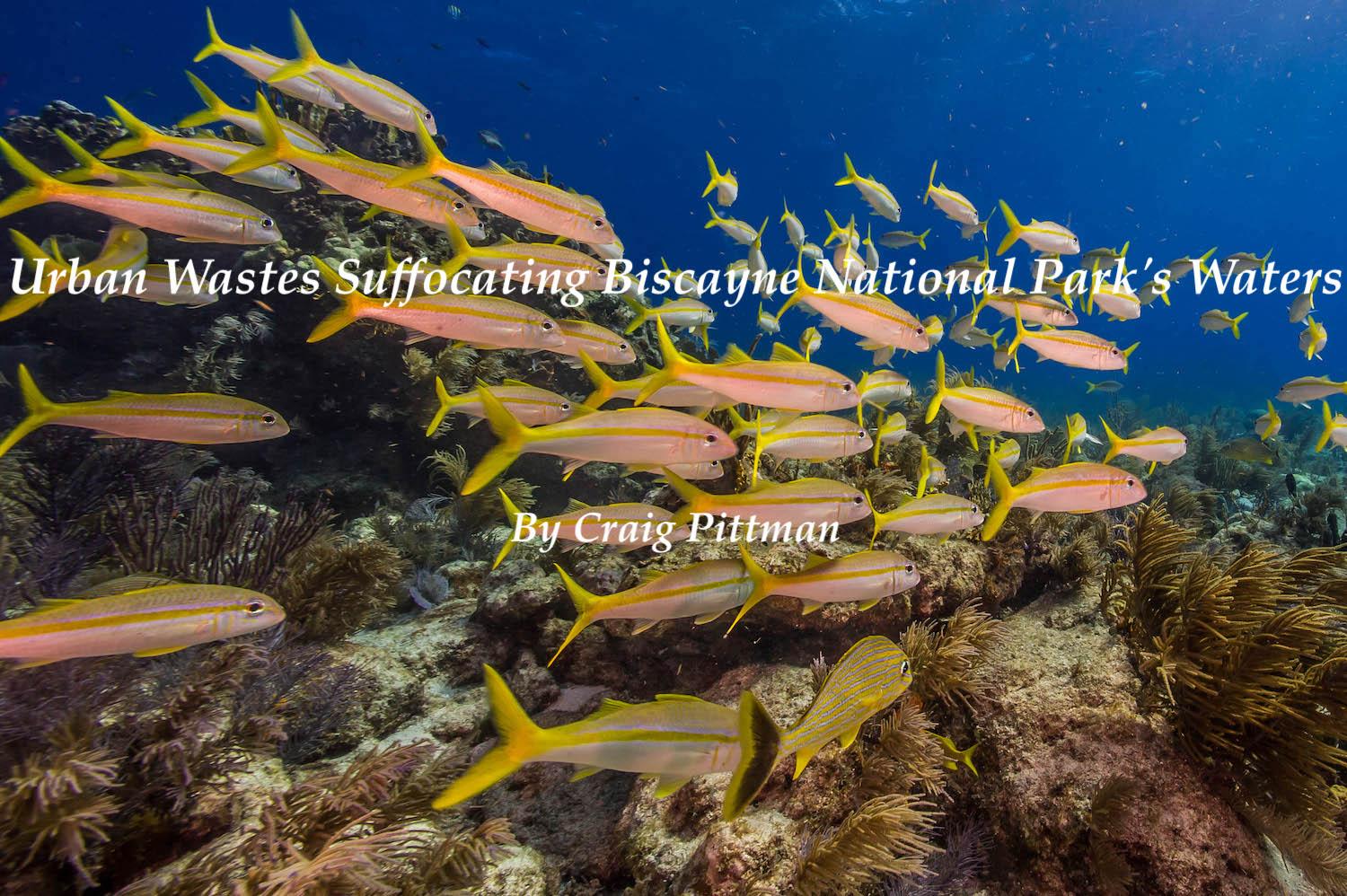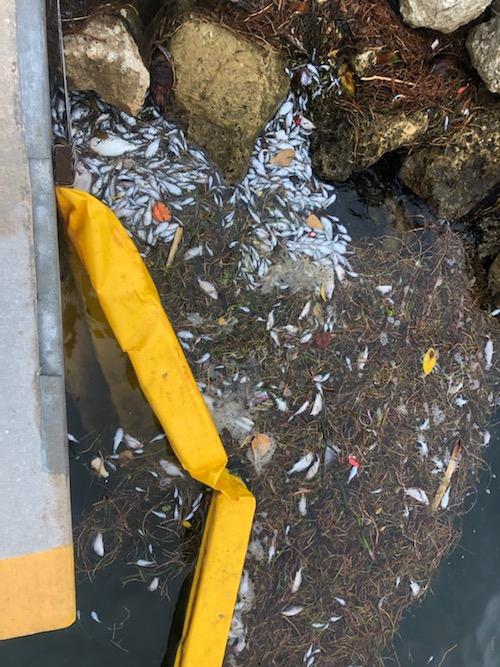
Biscayne National Park's colorful reefs and marine life are increasingly at risk from urban pollution flowing into the park's namesake bay.
MIAMI -- In 1968 Congress set aside what eventually became Biscayne Bay National Park to protect that environmentally valuable waterway from the rampant development sweeping across the South Florida peninsula.
But development is still taking its toll on the bay that gives the park its name. Three years in a row, fish kills have hit the bay. The most recent one was in October.
“Biscayne Bay is really in crisis,” said Miami Waterkeeper Rachel Silverstein. “We’re seeing the collapse of the whole ecosystem…The bay has reached a tipping point.”
The first fishkill hit in 2020, piling up more than 27,000 dead fish and other forms of marine life and shocking many who had no idea the bay was in such bad shape. The putrid smell of so many dead fish convinced the previously skeptical that the bay really did have a problem. The same calamity struck last year, although the kill was smaller. The one this year is the worst since 2020, Silverstein said.
“We know what’s causing this – the lack of oxygen,” said Henry Briceno, a professor who studies water quality at Florida International University’s Southeast Environmental Research Center. This is a potential disaster for more than just nature-lovers and waterfront property owners, he said.
“The economy of this whole area depends on the water quality of the bay,” he said.
The decline in water quality is the result of human pollution pouring into the bay and fueling a massive algae bloom that kills the seagrass, he explained. Similar disasters are occurring in other waterways around the country, such as Chesapeake Bay and Florida’s Indian River Lagoon.
“The whole thing is cascading toward making a perfect storm for the bay,” he said.
This was not the future that park advocates had in mind back in the 1960s.

Urban pollution is being blamed for massive fishkills in Biscayne Bay/Miami-Dade County
Back then, the bay was being threatened by a pair of projects. One, called Islandia, would have turned the chain of islands around the bay into an upscale development a la Key Biscayne with beachfront homes, lavish resort hotels and upscale shopping centers.
The other, SeaDade, called for a massive dredging project to construct a 40-foot-deep passage across the seagrass beds and coral reefs in order to create the world’s largest oil refinery and shipping port near Homestead, the town now considered the gateway to Everglades National Park.
A coalition of anglers and birdwatchers fought both proposals.. The battle was a rough one. One of the leaders of the save-the-bay movement, fisherman and Pan American Airlines employee Lloyd Miller, said their opponents tried to get him fired, vandalized his car and even poisoned his dog.
Against long odds, they won. Congress first declared the southern half of Biscayne Bay a national monument and then expanded it to a park with 170,000 acres – 95 percent of it water.
But that park protection doesn’t cover the entire bay. The northern part is enclosed by Miami and Miami Beach’s sprawling development. As a result, it’s the recipient of much of its sewage leaks, septic tank waste and fertilizer-laden stormwater runoff.
Miami-Dade officials have known about these problems for years, Silverstein said. In fact, a 2019 grand jury report warned that “the declining quality of this body of water may become irreversible.”
Federal officials had given the county millions to wean the region off septic tanks and get residents switched over to more reliable sewer systems. Instead, Silverstein said, the county continued approving new development that relied on septic tanks to handle waste.
"There are10,000 septic tanks still in use scattered through the watershed,” Briceno said.
Meanwhile, the area’s sewer system capacity has not kept pace with the amount of development relying on it, which has led to repeated sewage spills.
As a result, the water quality in the civilization-surrounded segment of the bay has nosedived. That means when other conditions go sideways, the bay isn’t sufficiently resilient to cope with it, said Pamela Sweeney, senior manager with Miami-Dade County’s water resources division.
Around 80 percent of the northern bay’s seagrasses have died off, she said. That’s the key to the problem. Sweeney compared loss of the oxygen-producing seagrass to humans losing their lungs.
“We just had the hottest summer on record, the hottest since we began keeping records in the 1890s,” Sweeney said. “High temperatures put a heavy demand on the available oxygen in the bay…When you lose the lungs, you lose the ability to offset the loss of oxygen.”
So far, no fish kills have occurred in the section of the bay that’s part of the park, but Sweeney said, “The decline is throughout the entire bay.”
Park officials say they’re keeping an eye on the situation. Researchers recently found the oxygen levels in the park’s water were extremely low.
“Climate change, with the associated changes in sea level and temperatures, will also further exacerbate problems,” warned Morgan Elmer, the park’s natural resources chief.
The repeated fish kills in the northern bay have shocked local and state officials into taking action the way the less visible loss of seagrass did not. They set up a task force that drew up 68 actions that needed to be taken, Sweeney said. The 68 included tackling the area’s aging stormwater and sewer systems, getting people off septic tanks,
One of them: Appoint a Chief Bay Officer to advocate for clean water and serve as a liaison between the county and its 34 municipalities.
That job has been filled by former South Florida Water Management District governing board member Irela Bague.
“We should have started this stuff 20 years ago,” she said.
So far, she said, the county has accomplished some – though far from all -- of the 68 goals to clean up the bay. For instance, it has passed the state’s strongest ordinance banning the sale of fertilizer during the summer rainy season. There’s a push to remove 60 derelict vessels from their watery graves, and the county is making surprise inspections of waterfront contractors at work to see if they’re abiding by the rules on runoff.
Meanwhile the county has designated $22.9 million to spend on those projects, and the state has recently pledged another $22.7 million.
Melissa Abdo, regional director of the National Parks Conservation Association, said the whole bay would benefit from the Park Service finally following through on its promise to create a no-fishing marine reserve.
Seven years ago, Florida worked with the Park Service to create a Marine Reserve Zone that would cover approximately 6 percent of Biscayne's waters, or 10,522 acres. But there were objections from the $6 billion-a-year South Florida fishing industry, which prompted several House members and the state’s two senators, to object. The park shelved the idea.
The NPCA sued the Department of the Interior and Biscayne National Park in December 2020 over the park’s failure to implement that no-fishing marine reserve zone and phase out commercial fishing. The suit remains active.
Bague was not enthusiastic about the reserve idea, which is not one of the 68 on her roster, noting, “There are so many designations. Another one is just another one.”
Despite the sudden rush to clean up the bay now, expect progress to be slow. Asked if the bay is likely to see another fish kill next year, Bague said, “We can’t rule out another one.”

